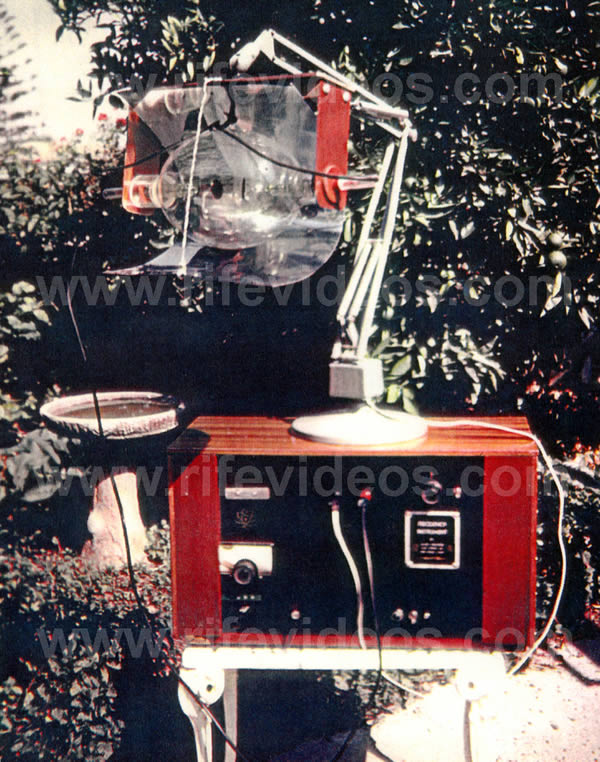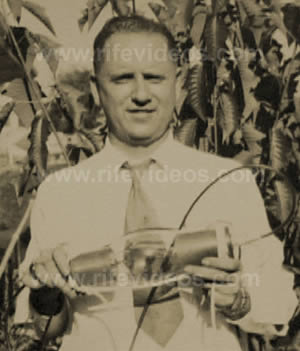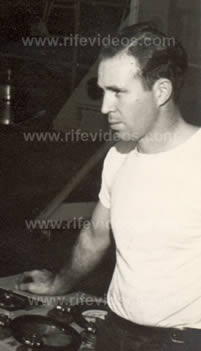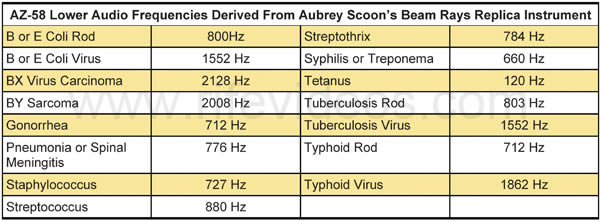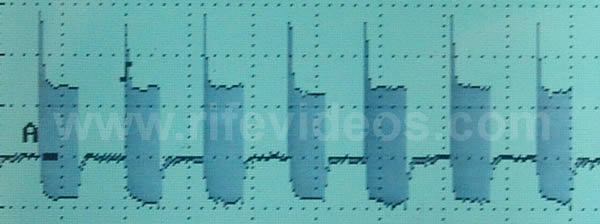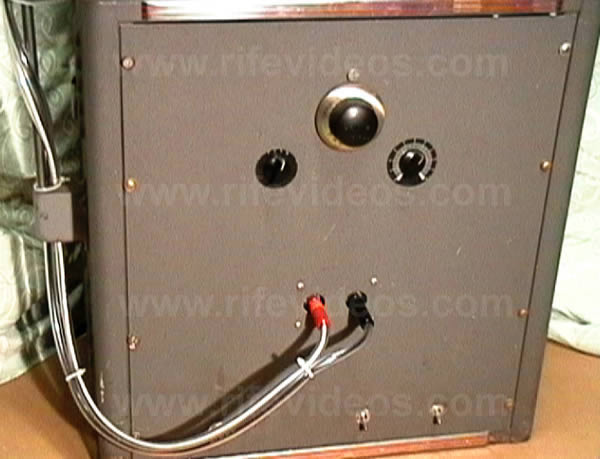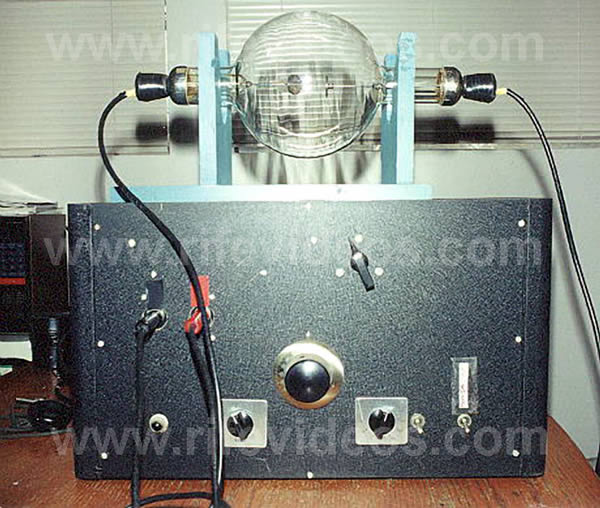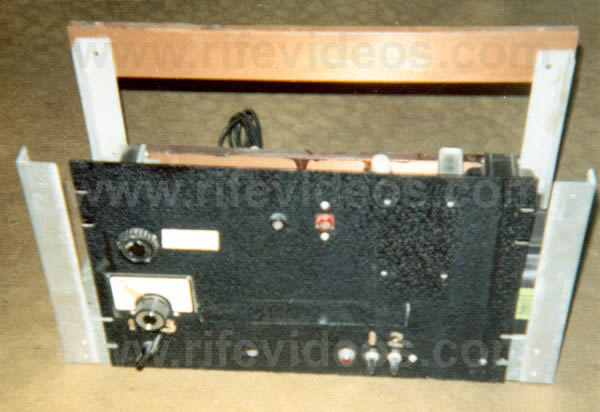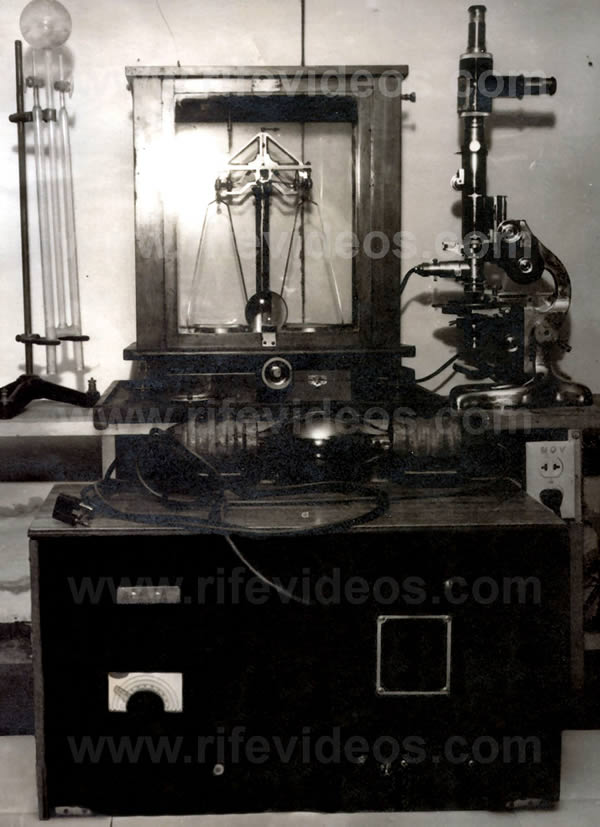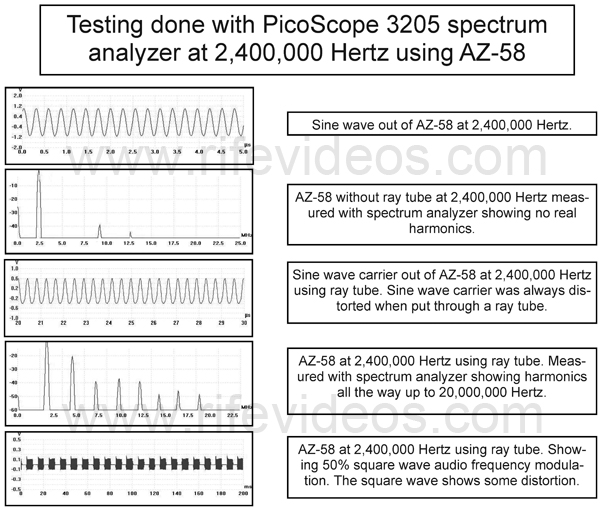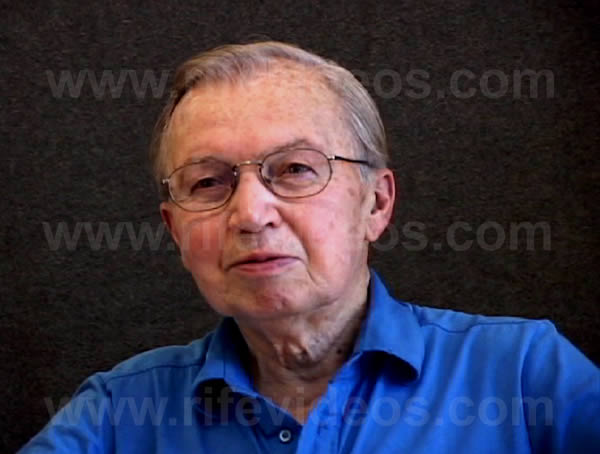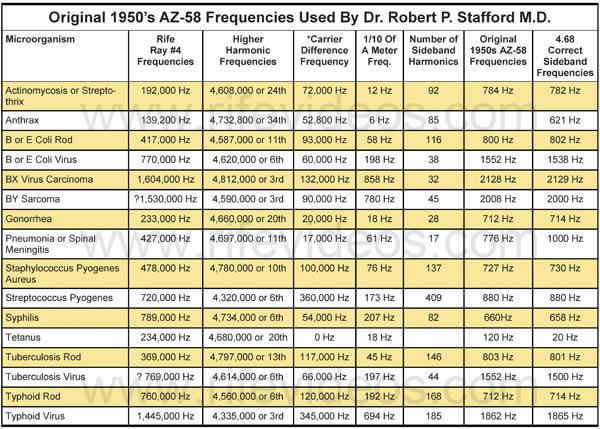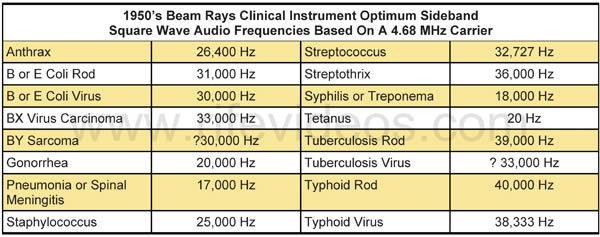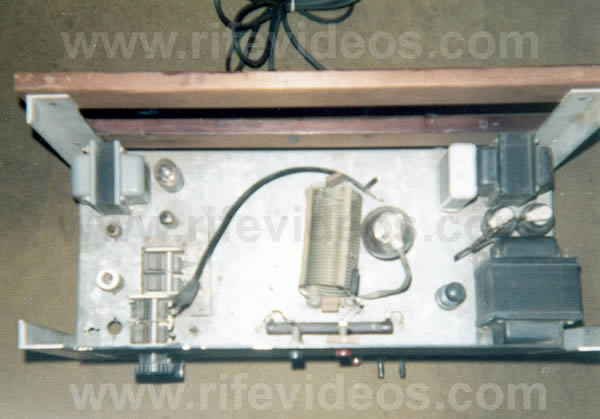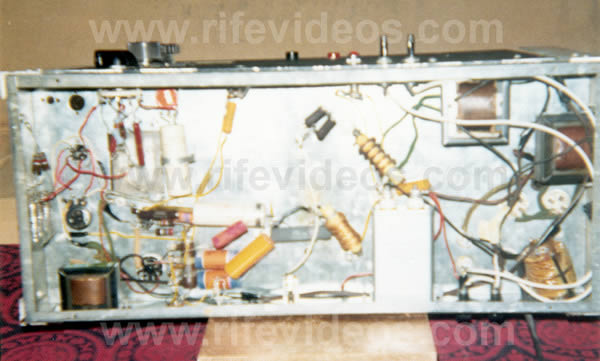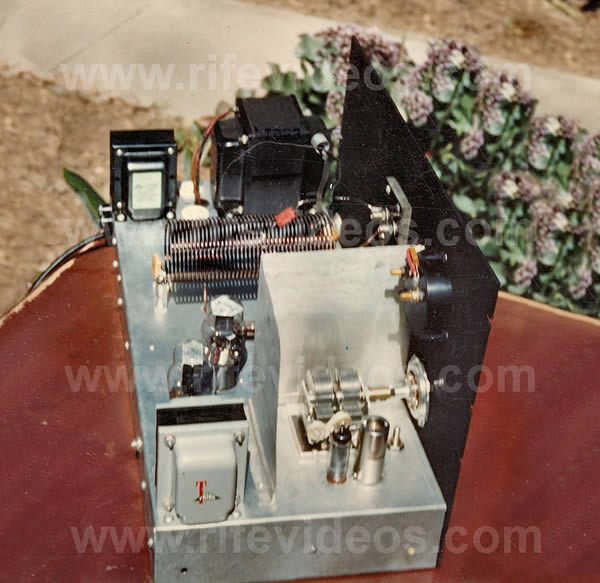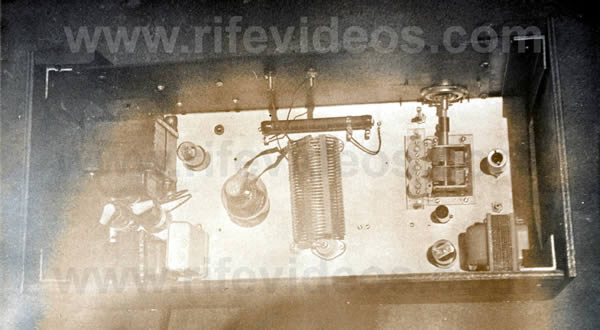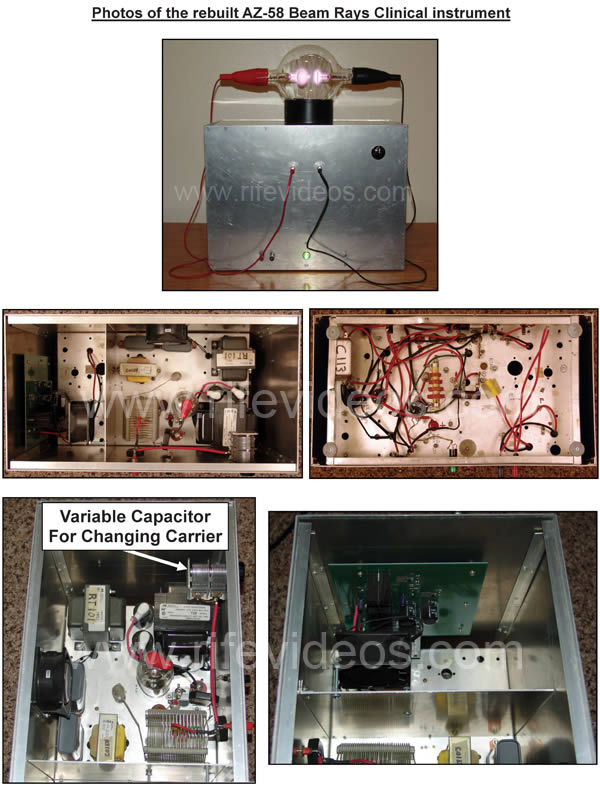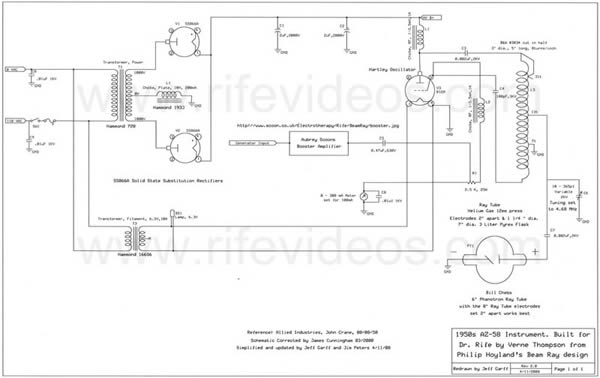| Home | Accessory Kit | Marsh CD Collection | Library | Contact Us |
Chapter #12
Dr. Rife and Verne Thompson's
1950's AZ-58 Beam Ray Replica Rife Machine
1) Used a ray tube.
2) Variable RF carrier between 2.2 and 5 MHz. (First used a 4.68 carrier).
3) Modulated square wave audio frequencies onto the sine wave RF carrier frequency.
4) Power usage was about 460-watts. Output to the ray tube about 50 to 75-watts.
With the knowledge gained from obtaining the original Rife Ray #5 or Beam Ray Clinical instrument, we know that the 1953 AZ-58 design is an updated replica of Philip Hoyland's Beam Ray Clinical Rife Machine. The 1953 version was updated with newer component parts. Dr. Rife’s engineer, Verne Thompson had been building this type of Rife Machine during the 1940s and 1950s. We will now cover this information in more depth. This style of instrument worked well as long as it was using the sideband method. From the stress of the Beam Ray Trial, Dr. Rife became an alcoholic and all that he had worked so hard to accomplish was almost destroyed. Many of the doctors had returned their instruments because of AMA threats. Some of these returned Beam Ray Clinical instruments Dr. Rife parted out and sold to anyone who wanted radio parts. Under these circumstances, Beam Ray Corporation eventually closed its doors. Verne Thompson became Dr. Rife’s engineer around 1940 and built the Beam Ray style Rife Machines during the 1940s and 1950s for anyone who wanted an instrument. The documents show that back in 1939 Dr. Rife wanted to go back to the original principles of his instrument rather than use Philip Hoyland’s harmonic Beam Ray Clinical design. This is what Dr. Rife said in a 1939 letter sent to Dr. Gonin:RIFE: “I spoke only Friday evening to a Mr. John Chamblin, a radio man now connected with Beam Rays Inc., about the redesign and building of a device according to the old Rife Ray principles; as the present instrument has been so deviated away from that old principle that it is nowhere near the same...those devices which you have are merely working on a harmonic and not a true frequency; and in our research on electronics, we definitely know that there is no possible way of controlling electrical harmonics of a frequency.” (Letter from Dr. Rife to Dr. Gonin, May 14, 1939. Page 1 of 3)
Because Dr. Rife didn’t understand Philip Hoyland’s harmonic sideband method he believed that the harmonics could not be controlled. Sidebands can be controlled by the audio frequency which is used to create them. Had Dr. Rife been given the understanding of how the instrument worked he would have known that they were controllable. Because of this misunderstanding, Dr. Rife wanted to go back to the original designs of his earlier Rife Machines. It is also a historical fact that he never did go back to using his original designs like the Rife Ray #4. There is a reasonable explanation for this. Back in the late 1930s and early 1940’s the FCC began controlling the airwaves and hundreds of new radio stations were being granted licenses. The RF M.O.R. frequencies which were output by the Rife Ray #3 and Rife Ray #4 were almost all in the A.M. radio band of frequencies and would interfere with these new broadcasting stations. These events probably brought about the continued use of Philip Hoyland’s Beam Ray Clinical Rife Machine since it operates out of the A.M. band and in the low ham radio range. In Chapter 9 of this report we also read that Dr. Rife tested Philip Hoyland's instrument, in about 1940, when he had Verne Thompson rebuild Dr. Yale's Beam Ray Clinical instrument. In those tests, Dr. Rife found that Philip Hoyland's design would devitalize all the microorganisms. The tests that were done by Dr. Rife showed that this style of instrument worked. This meant that he really didn't need to go back to his earlier designs even though he may have wanted too.
There are a few important facts that should be pointed out. Dr. Rife at any time could have had an original Ray tube instrument built. He had a Rife Ray #4 in his lab that could have been copied. I am sure that he also had access to the Beam Ray Laboratory instrument. These facts, I believe show that it was probably because he knew that Philip Hoyland's design was a good design that he continued to use it. It could also be because of the FCC regulations Dr. Rife either had to use the Beam Ray Clinical instrument design or no longer build one. We know, from the documents, that Verne Thompson was copying Dr. Couches’ instrument with its fixed RF carrier frequency of 3.30 MHz. This carrier frequency was well above the A.M. band of radio stations. Since the Beam Ray Clinical instrument used the higher harmonics of the original Rife Ray #4 frequencies this would not cause any problems with the A.M. radio stations. The FCC was, at the least, a contributing factor in why Dr. Rife continued to use Rife Ray #5 or the Beam Ray Clinical design.
With the understanding of this information let us continue on with the history of Dr. Rife’s instruments. John Crane met Dr. Rife in 1950 when he inquired about purchasing a drafting set that Dr. Rife was selling. John Marsh met John Crane in 1952 when they were both working at Convair. See the photos below. John Crane is in the photo on the left and John Marsh is in the photo on the right.
They both went to talk to Dr. Rife in 1953 to see if he would be willing to help with John Marsh’s wife who had cancer. In Dr. Rife’s 1961 deposition #123-125 we have the verification that Dr. Rife gave John Crane his frequencies in 1950:
COMPARET: “Did you ever explain to John F. Crane, one of the defendants in this case, the principles upon which your electronic frequency-generator is used in the treatment of diseases?”
RIFE: “Yes in 1950.”
COMPARET: “Did you also inform him of the particular frequencies which you had found to be effective in the treatment of various diseases?”
RIFE: “Yes. Verne Thompson and I gave the frequencies to John Crane.”
COMPARET: “When did you furnish him with this information?”
RIFE: “In 1950.”
Dr. Rife always said that almost all his frequencies were in the upper bands (139,200 Hertz to 1,607,450 Hertz) so we know that he gave these high RF frequencies to John Crane in 1950. These frequencies would have been the frequencies used in the Rife Ray #4. The audio frequencies that were used in Dr. Couche's Beam Ray Clinical instrument also may have been given to John Crane at this time. There is an interesting correlation of these audio frequencies that needs to again be mentioned at this time which ties these machines together. The higher audio frequencies, which produce the sideband spacing, used in the 1950’s Aubrey Scoon, Verne Thompson Beam Ray Clinical instrument were 10 times higher than those used in the Verne Thompson 1953 AZ-58 Beam Ray Clinical replica. It is apparent that these higher audio frequencies were lowered in the 1950s by Dr. Rife, John Crane and John Marsh and were used in the AZ-58 replica instrument. This gives us the knowledge that these audio frequencies came from Verne Thompson’s reading of one of these Beam Ray Clinical instruments. The chart, shown below, is a list of the lowered audio frequencies which were used in the 1953 AZ-58.
The original Beam Ray Clinical instrument we have has an RF carrier frequency of 3.80 MHz. Aubrey Scoon’s Beam Ray Clinical replica instrument’s RF carrier frequency is 3.30 MHz. The audio frequencies Aubrey Scoon’s instrument used, we showed earlier in this report, will not work with the original Beam Ray Clinical instrument that we have because the audio frequencies have to be matched to the RF carrier frequency. The AZ-58's RF carrier frequency was set at 4.68 MHz as written down on the schematic and as per the FCC. Aubrey Scoon’s Beam Ray Clinical instrument audio frequencies would not produce the correct sideband spacing with the AZ-58 RF carrier frequency because the audio frequencies are calculated to work with a 3.30 MHz RF carrier frequency not a 4.68 MHz RF carrier frequency. This information also verifies to us that Philip Hoyland was using different RF carrier frequencies in the Beam Ray Clinical instrument. It also indicates that both Rife and Verne Thompson did not understand the importance of using the correct RF carrier frequency with the correct audio frequencies.
John Crane said this in his "Crane Report":
CRANE: “The instruments were completed by Crane and Thompson in 1953, but the test results were negative.” (“The Crane Report” page 6)
With the carrier frequency set at 4.68 MHz as per their FCC license, instead of 3.30 MHz, the audio frequencies they used would not make the correct sideband spacing and the instrument wouldn’t have worked as they expected. Logically, if they understood the relationship of the RF carrier frequency and the audio frequencies they would have changed the RF carrier frequency back it to 3.30 MHz or recalculated new audio frequencies to work with the 4.86 MHz RF carrier frequency, but they didn’t do either.Even with the wrong RF carrier frequency Dr. Rife, John Crane, and John Marsh would have first tried the higher audio frequencies in the sine wave waveform like the original Beam Ray Clinical instrument used. Apparently when this didn’t work, because the carrier frequency was wrong, they lowered the audio frequencies by a factor of 10 times and then changed the sine wave waveform to a square wave waveform. This appears to be the first time a true square wave was used. This change from sine wave to square wave wasn’t really necessary since the circuit design will create a square wave looking waveform out of a sine wave anyway. The photo, shown below, is of the AZ-58 waveform.
Using the square wave waveform would not have changed how the sidebands would have worked. But it would have created true square wave harmonics which the instrument did not have when it was using the sine wave waveform. John Crane mentions that this is when the instrument started to work better. So we are left to assume that he was referring to the use of the square wave waveform. It is ironic that they used a square wave waveform that produces harmonics in order to get the instrument to even begin to give them any results. Had they really understood how the audio frequencies interacted with the RF carrier frequency they would have recalculated the audio frequencies to work with the new 4.68 MHz carrier frequency instead of lowering the audio frequencies by a factor of 10 times. Then the square wave waveform change would not have been necessary. These important facts that have been pointed out again show they did not understand the relationship between the RF carrier frequency and the audio frequencies. All they managed to prove is neither the carrier frequency nor the audio frequencies will do anything by themselves.
This change from sine wave to square wave also created a whole new methodology of using frequencies. Instead of relying on the interaction of the sine wave audio frequency with the sine wave RF carrier frequency to produce the correct sideband harmonic M.O.R. to devitalize the organisms they were now depending only on the harmonics from the square wave waveform to hit the correct M.O.R. frequency. This change was also another indication that they didn’t understand how the Beam Ray Clinical instrument worked.
Another thing that shows that they did not understand how the Beam Ray instrument worked is the fact that they didn’t recalculate the audio frequencies to properly use the square wave harmonics to hit the high-frequency M.O.R.s. This shows that they believed that the lower audio frequencies, which they were using, were the M.O.R.s. of the organisms even though they had no harmonic relationship with the original M.O.R.s. used in the Rife Ray #4. We must point out that the square wave mathematical method we are talking about here is completely different than the harmonic sideband method which Philip Hoyland used.
In many of the documents, we find that both John Crane and John Marsh firmly believed that these lowered audio frequencies were the M.O.R. frequencies that would devitalize the organisms. Even Dr. Rife appears to have believed that the audio frequencies were the M.O.R.s. as long as they were used with Philip Hoyland’s Beam Ray Clinical design. In Dr. Rife’s original equipment like the Rife Ray #3 and the Rife Ray #4, he knew that the M.O.R. frequencies were the high RF frequencies. But since Dr. Rife didn’t really understand exactly how Philip Hoyland’s instrument worked it appears that he accepted the concept that the audio frequencies were the M.O.R.s, or created the M.O.R.s, as long as they were used with that style of instrument. Without understanding these facts it is hard to understand the rest of the history of Dr. Rife’s instruments. The fact that they believed that the audio frequencies were the M.O.R.s. compromised the effectiveness of the 1953 AZ-58 Beam Ray Clinical replica.
Below are four photos of ray tube instruments that Verne Thompson built. The first instrument was Aubrey Scoon’s 1950’s Beam Ray replica. The second instrument is believed to have been built in 1947 but some of the transformers are 1960’s vintage which indicates it was built in the 1950s or 1960s. The audio frequencies used in it were even lower than the 1953 AZ-58. Since all the evidence we have shows that the lower audio frequencies started with the 1953 AZ-58, this indicates that the instrument was not built in 1947, but was built sometime after 1953. The third and fourth photos are of two AZ-58 instruments that were built by Verne Thompson in 1953 for Dr. Rife, John Crane and John Marsh of Life Labs Co.
All four of these instruments, like the Beam Ray Clinical instrument, had the fixed Hartley Oscillator section which created the RF carrier frequency. Verne Thompson changed the 809 tubes to the 812 tubes as he updated the instruments from the 1940s to the 1950s. All three instruments also had one main frequency dial for adjusting the audio frequencies. The other two smaller dials were for adjusting the modulation amplitude of the audio frequencies and changing the audio frequency bands. These bands would take you through the various audio frequency ranges. The AZ-58 was limited to about 6000 Hertz, using 3 bands, because they lowered the audio frequencies. The original Beam Ray Clinical instrument we have frequency range went to just over 42,500 Hertz using 4 bands. The 1950’s Aubrey Scoon Beam Ray Clinical replica instrument could go to about 200,000 Hertz using 4 bands. Other than the bands there is very little difference in the way these instruments worked. We built two of the three, tested them, and found no significant difference other than the use of sine or square wave audio frequencies. At any time the AZ-58 could have been changed to work on the original Beam Ray Clinical sideband method just by adding a fourth band and then recalculating the audio frequencies to work with the 4.68 MHz RF carrier frequency. As pointed out before we made some tests with the spectrum analyzer to see if square wave could be used instead of a sine wave in creating the proper sideband spacing and found that the square wave waveform produces the same sidebands as the sine wave waveform.
The basic design of Philip Hoyland’s Beam Ray Clinical instrument is very apparent when you compare the schematics. Six of the 1953 AZ-58's were originally built by Dr. Rife, John Crane, and John Marsh. We decided to test the AZ-58 with the spectrum analyzer. Below is a graph so you can see the results of these tests.
The instrument called the AZ-58 is significant because we have more information about what took place in the 1950s than any period before this. At this time in the 1950s, John Crane and John Marsh recorded interviews with Dr. Rife, Dr. Couche, Ben Cullen, Henry Siner and many other individuals who were key players in the early years of Dr. Rife's work.
We will now cover in more detail the history of the 1953 AZ-58 instrument so we have more information about this instrument. Some of the information comes from the John Marsh Collection of Rife audio CD's. As we said, in 1950 John Crane met Dr. Rife and in 1952-53 he met John Marsh. John Marsh became John Crane’s supervisor at Convair Aeronautics when John Marsh moved from Tucson, Arizona to California. John Marsh’s wife had cancer and they were not able to help her in Tucson. The doctors recommended that he take her to San Diego for specialized care. John Marsh and John Crane became friends. John Crane told John Marsh about Dr. Rife and they went to see him. Dr. Rife gave them an old Beam Ray Clinical instrument which they had Verne Thompson repair. John Crane and John Marsh then used this instrument on John Marsh’s wife and after several treatments, John Marsh said she fully recovered. Here are John Marsh's statements which he made in 1976 and 1986:
MARSH: (1976) “I met this Rife. I said Dr. Rife, I said, my name is John Marsh, I’ve got a wife that’s dying. She’s got cancer of the uterus.” Dr. Rife said: “I won’t touch that thing with a 20 yard pole.”
After some discussion Dr. Rife said:RIFE: “I have an old instrument down here in the basement.”
MARSH: “I dug up that old instrument and of course it had tubes in it, antique stuff, and so I rebuilt the darn thing.” (John Marsh Rife CD's, CD 10 track 1)
MARSH: (1986) “I went to see him [Dr. Rife], and I talked with him and he said he didn’t want to have any part of it...I said look, I got a wife that’s dying and I need your help! And so I got him out of his cocoon, so to speak, and we took an old instrument and rebuilt it. And I treated my wife and by darn all the pain left her and she got well.” In another part of the tape he said: “I discovered that this Dr. Rife was a very great individual...I told John [Crane], I said look if we have any of those old instruments laying around loose, let’s rejuvenate one of them and see if we can get my wife well. Well Verne Thompson who was with the San Diego police department radios, uh, radio expert, uh, had built some instruments and they were antiques when I saw them.” (John Marsh Rife CD's, CD 2 track 3)
John Marsh and John Crane then decided they would like to work with Dr. Rife and try to get the frequency instruments rebuilt and back into the doctor’s hands. They wanted to help people who were suffering from many incurable diseases. From earlier quotes, we learned that Verne Thompson had worked on Dr. Yale’s Beam Ray Clinical machine. He knew how to build these instruments and this is why John Marsh and John Crane had him repair the instrument that Dr. Rife gave them. It is apparent that Verne Thompson knew this instrument’s circuit designs very well but he didn’t understand how the Beam Ray Clinical instrument was using harmonic sidebands to hit Dr. Rife's higher harmonic M.O.R.s. From a patent application that Dr. Rife and Verne Thompson filed we know that Verne Thompson also believed the audio frequencies were the M.O.R.s. This document leads us to only one conclusion; no one in the 1950s understood how Philip Hoyland’s sideband spacing method worked.
John Crane in his later years (1970's & 1980’s) was not being very truthful in some of his statements. He said this in his paper entitled "The Crane Report":CRANE: "Unfortunately, Rife had enlisted the help of electronic experts in the 30's who never wrote down the details of the instruments. Rife was unable to duplicate the marvels of his earlier Frequency instruments." (The Crane Report, page 6).
The documents we have read in this report show that Dr. Rife was having Verne Thompson build and repair the Beam Ray instruments originally built in the 1930s. For this reason, we know that John Crane’s statement, in his report, was not accurate. The facts have shown that this instrument design came from Philip Hoyland. It was Verne Thompson who updated the Beam Ray Clinical instrument for Dr. Rife, John Crane and John Marsh in 1953. If Verne Thompson was building these Beam Ray Clinical instrument then he surely would have had a schematic for them.
Others have felt that John Crane took advantage of Dr. Rife. John Marsh also believed that John Crane took advantage of Dr. Rife in the 1960s and early 1970s before his death. Two statements from his letters confirm this belief:
MARSH: “I’ve much of Rife’s original research data in my care. Given to me by Rife. John Crane knows nothing of it or my research, nor am I interested in his (assistance?) as I’ve done quite well, not money-wise but intelligence-wise, very well without him. He had kept Rife in alcohol with the front of friendship, thus taking everything he could from Rife when Rife wasn’t alert to John’s intentions.” (Letter from John Marsh to Christopher Bird 08-03-1982).
MARSH: “I loved that man [Dr. Rife]. A real live gentleman in every way possible. Crane was and still is so money-mad that he couldn’t see these finer things in Rife. I being an artist could see this beauty. Truly a great man in any way and every way possible. How grateful I am that I had the honor to work beside him and to know just a little about him. Very few any greater.” (Letter from John Marsh to Christopher Bird 08-23-1982).As can be seen from these two quotes John Marsh believed John Crane took advantage of Dr. Rife in the 1960s and early 1970s but the evidence does not support this in the 1950s and early 1960s. Here is a quote from the John Marsh Collection "Trip to Dayton Ohio Papers" and Gonin Papers. Dr. Rife, John Marsh and John Crane were talking at great length about John Marsh’s trip to Ohio to see Dr. Robert P. Stafford M.D. In the Gonin papers, they talked about the frequencies. I would recommend that everyone read these papers because they show that Dr. Rife, John Crane and John Marsh worked as a team. They also show that John Marsh and John Crane considered the frequencies to be Dr. Rife’s and the AZ-58 Beam Ray replica instrument to be Dr. Rife’s instrument. The following statements confirm this:
RIFE: “Well I have lived my life for the benefit of humanity, and it is the end result of the accomplishment.”
MARSH: “Yes, now here is what I did tell them. They wondered where I fit into the picture. I told them I had lay outs at the base, I designed part of it. You would say that I was possibly not an exactly an inventor, but I think we are all co-inventors of a sort by adding what we think would make the instrument better and if they try to validified [verify] any of the statements that I have said to them please don’t let me down, and say no this isn’t so, which might upset what might be the truth to them. I mean just by accident. Now what I mean by that is this. I don’t think that I have in my own right lied to them. I did [didn’t] try to impress them with the idea that I was the one that did it. I did impress that you [Dr. Rife], John Crane and myself had worked together on this thing, but that you [Dr. Rife] were inventor and John [John Crane] was the designer and inventor, co-inventor and myself for putting this thing together and making it. They asked if I helped putting this thing together and making it from time to time. I couldn’t tell them that I didn’t, because if I had built up a feeling in them that I knew nothing about what I was doing; psychologically that could have torn down, or have caused delay the foundation that now is laid. Now I think we have a solid footing there. I under no circumstances would want that torn down, and I will not under any circumstances accept the credit for this instrument as being invented, because it is Rife’s instrument as printed on the plate in front and that is one of the reasons in building you up to them, which I don’t think is unwarranted; not by a darn sight, and that is why they want you there. They want to hear you talk, and they also want to know your past experiences with the people of La Jolla and also I was very happy to have received the paper concerning the Dr. etc., because I’m sure Stafford will contact every blooming Dr. that you had given him to me and I turned over all the letters to him, because I didn’t want anything to stand in the way if he could contact him, now whether he would do that, before he would talk to the group, and I do not know. I suppose he will, but he wants the truth as badly as you do. Now I don't know an easier way it can be done. I don't think there is going to be an easy way to get it on, but I think I’ve outlined this thing. I studied the moves I was going to make before I ever went there. I studied what I was going to do if I had the opportunity to do so, which I did.”
RIFE: “Well I think that you did a very excellent job.” (1957 John Marsh trip to Dayton, Ohio #8, 9 and 16)
And in the John Marsh Collection, Gonin Papers we read:
CRANE: “So the frequencies [audio] we have written down. I will give you those or Rife will give them to you. I think you ought to have them. Each one [organism] has a different frequency, you see. I don’t remember any of them off-hand. I should memorize them all, but I haven’t yet. I’ve just written them down and they are in the lab.”
GONIN: “Those frequencies that you have written down, would only apply to your own machine [AZ-58], wouldn’t it?”
CRANE: “That is because they have been calibrated for each machine. Each machine has its own calibration.”
GONIN: “And that’s constant?”
CRANE: “Yes.” (John Marsh Collection, Gonin and Siner Papers, Page 15,)
After reading these documents the facts stand out that all three of these men knew the audio frequencies and they were not John Crane’s invention. Both John Marsh and John Crane considered the instrument to be Dr. Rife’s. Dr. Rife also had a plaque on the front of the instrument with his name on it. It is also clear from John Marsh’s papers that Dr. Rife was not on the sidelines but he a working partner in Life Labs. Dr. Rife by this time had become what some people call a "working alcoholic." This type of drinker would have a little to drink during the day to take the edge off but would not be a total drunk. The documents show that Dr. Rife knew the audio frequencies that were used in the AZ-58. But it is clear that he didn’t understand how those audio frequencies worked with the RF carrier frequency with Philip Hoyland’s design. On the Rife CD's all of Dr. Rife’s recorded conversations were very positive about the AZ-58 instrument. This does not sound like a man who was ignorant of what was going on, as some have claimed.
Anyone who reads the documents from this period of time can tell that there were a lot of high hopes for this instrument and the lower square wave audio frequencies it was using. Now the real question is how well did this instrument work when it was only working on square wave harmonics? There were a lot of good reports on how well the instrument worked but what really counts is how well it worked in the hands of the doctors who used it on their patients. Dr. Robert P. Stafford M.D., used the AZ-58 for 5 years on his patients and wrote a report and sent it to Dr. Rife, John Crane, and John Marsh. The photo below is a picture of Dr. Robert P. Stafford M.D.
Dr. Stafford's report is very favorable on many conditions that he used the AZ-58 on but when it came to cancer this instrument did not work as well as the Beam Ray high-frequency harmonic sideband method. Dr. Stafford’s report showed he treated 16 cancer patients and had a varied response rate using the AZ-58 on cancer. We must point out that the instrument did temporarily help some of his cancer patients while others did not see any benefits. Two of the women that he treated received a lot of benefits but died from other complications. This made it so that he could not say they were cured by the instrument. When the first woman was autopsied she only had a small amount of cancer left in her breast. When Dr. Stafford started treating her she had cancer in several other places including her neck. Had she not died from a fall she probably would have fully recovered.
The second woman had cervical cancer for which other doctors used a great deal of radiation therapy. Dr. Stafford treated her at the hospital and after about four weeks she went home. She died of radiation damage that was done to the tubes that go from the kidneys to the bladder. When she was autopsied they found no cancer cells in her abdomen. In this case the cancer was completely gone. Since neither of these women lived for at least five years they could not be considered cured. So Dr. Stafford could never say that he had cured anyone of a terminal malignancy. He said this about the AZ-58 square wave audio frequency instrument:
DR. STAFFORD: “As yet, we have failed to “cure” any case of advanced, terminal malignancy. It appears in several instances that we may have impressed the disease favorably, temporarily. It is difficult to rule out the psychological, morale booster effect to the terminal patient when some definitive effort is made again in his behalf. However, several improvements have appeared to be more physical than emotional...All the patients in the series were treated with the same frequencies (e.g., 728 - 784 - 880 - 2008 - 2128). Perhaps these frequencies may be wrong, or only nearly correct.” (John Marsh Collection, Dr. Stafford’s Report on using the AZ-58, page 4).
It is clear that Dr. Stafford was questioning the accuracy of the square wave audio frequencies and felt that something was wrong. Everyone who has been around Rife technology for a long time has seen the very same results as Dr. Stafford. From time to time we see that someone has an amazing experience of recovery from cancer but for the majority, this does not happen. Today these frequencies 728, 784, 880, 2008 and 2128 Hertz which Dr. Stafford used are the same frequencies used by just about everyone for cancer.
Many have wondered why the AZ-58 worked well for a few patients and not for others. We believe we know the reason why. The RF carrier frequency is the reason it worked. The AZ-58 RF carrier frequency was set at the new 4.68 MHz to comply with the new 1950's FCC license. Dr. Stafford changed the RF carrier frequency using the variable capacitor to operate between 3.10 MHz to 3.30 MHz with the two women who were treated for cancer. He also used this same RF carrier frequency with some of his other patients. If perchance the RF carrier frequency was set at about 3.20 MHz it would have been only about 15,000 Hertz off of the second higher harmonic of Dr. Rife's original BX cancer virus frequency, which was 3,214,900 Hertz. This second harmonic of the BX (1,607,450 X 2 = 3,214,900 Hertz) was the primary frequency used by Philip Hoyland in the Beam Ray Clinical instrument for the BX cancer virus. If an audio frequency of 2128 Hertz (AZ-58 BX audio frequency) was used, and it was, it would have created many harmonic sideband frequencies and the 7th harmonic sideband frequency would have hit Dr. Rife's higher harmonic BX frequency of 3,214,900 Hertz. We need to keep in mind that Dr. Stafford also used 728, 784, 880 and 2008 Hertz. It would have been almost impossible for him not to hit the BX frequency of 3,214,900 Hertz with one of the sidebands from all these frequencies. If we also take into account the “one-tenth of one-meter” tolerance frequency of 858 Hertz it gives room for the frequency to be off a few hundred Hertz and still work. What we have just explained is the reason why we think the AZ-58 worked so well on these two women.
It is also known that Dr. Stafford tried other RF carrier frequencies. Once he changed the RF carrier frequency the instrument would have been relying completely on the harmonics from the square wave waveform of the audio frequency. This would have greatly affected the outcome of his testing. The fact is the square wave harmonics method did not work as well as the Beam Ray Clinical sideband spacing method. The real problem is almost everyone believes the square wave audio frequencies are Dr. Rife’s true M.O.R. frequencies. The evidence shows that John Crane and John Marsh believed the audio frequencies were the true M.O.R. frequencies and they had given this understanding to Dr. Stafford. Without the correct understanding of how the instrument worked Dr. Stafford would not have understood how important the fixed RF carrier frequency was. If he changed it off of the 3.20 MHz RF carrier frequency many of the 16 cancer patients could have been affected negatively. Dr. Stafford followed these 16 people over many years and in some cases, things looked good at first, but the people eventually died from their cancer anyway. One thing that needs to be pointed out is we do not know if Dr. Stafford treated many of his patients over a long enough time period as Dr. Couche and the other doctors did their patients.
In the 1934 clinic, 16 patients who had cancer and tuberculosis were treated and considered clinically cured. This is quite a contrast; 100% success in 1934 using Dr. Rife’s high RF frequency method. And a very limited success rate on cancer for the low square wave audio frequency harmonics method. Only when Dr. Stafford accidentally used an RF carrier frequency close to the BX cancer virus frequency did the AZ-58 seem to get good results. Dr. Stafford used the AZ-58 instrument for a little over five years and sent his report to John Marsh. I am sure John Crane received it also. The big question that needs to be asked is why did John Crane and John Marsh continue to tell people these low audio frequencies were the frequencies which Dr. Rife used in the 1934 clinic when the medical proof showed they didn’t work as well as the high RF frequencies? This again clearly shows they did not understand the sideband method. We have to ask the question, why do people today continue to say these frequencies cure cancer even after they have seen the same results? Could it be because having had a few good results they ignored the evidence and fool themselves? By the time all the evidence was available, John Marsh and John Crane were in jail on three or four different legal counts, one of which was for treating a woman without a medical license.
Dr. Rife did not want to have anything to do with all the legal trouble they were in. He was able to avoid it because he never made any claims and he would never treat anyone. The legal problems shut down Life Labs. Had this not happened I wonder if Dr. Rife would have ignored this evidence? I do not believe he would have. He would have realized that the changes they made to the instrument which depended solely on square wave audio frequency harmonics compromised its effectiveness. I think Dr. Rife would have eventually realized that they didn’t fully understand how the Beam Ray Rife Machine worked and he would have gone back to the higher audio frequencies and put the RF carrier frequency back at 3.30 MHz. We will never know what he would have done because I do not think Dr. Rife ever read Dr. Stafford’s report. This is because John Marsh received the report after he and John Crane were released from jail. The troubling thing is, since so few really understand Dr. Rife’s early instruments and how Philip Hoyland’s Beam Ray Clinical Rife Machine worked, almost all frequency generators have been built using this limited square wave audio frequency harmonic method. The people who purchase these low square wave audio frequency instruments have been led to believe it is the same type of instrument used in the 1934 clinic. All because we didn’t know the truth. Are people today just fooling themselves also? Are we trying to get these same square wave audio frequency harmonic type instruments and the frequencies they use to do what Dr. Stafford could not get them to do? Cure cancer? We know there have been incredibly good results on many other conditions using audio frequencies which show this type of instrument and method is of great worth but the truth is sometimes hard to accept.
As we have already read, Dr. Stafford came to suspect that the audio frequencies were not true M.O.R.s. Another letter was written by Dr. Stafford to Dr. Edward Jeppson in Salt Lake City also confirms his concerns. He wrote this letter to Dr. Jeppson because he was having the same type of results that he was having. Here is his statement from his letter:
DR. STAFFORD: “Please excuse my format in the following letter for I intend to ramble a bit and forget strict grammatical dictum. I am writing you at this time partially because John Marsh informs me in a recent letter that you may be somewhat disheartened or at least worried about your role in the experimentations with the Rife Machine. Believe me, Dr. Edward I know how you feel for I too have been through this same feeling with this matter. I have observed clinical results after treatments with this gadget which I can scarcely believe myself. Yet, despite these good results, I have been confused by some rather simple failures such as a recent experiment which I conducted at Good Samaritan Hospital where we used the machine to treat some cultures of Staph Aureus and Strept. Fecalis. In this work, we failed to inhibit growth at all or influence the cultures with the Rife Rx. I sent the results to John Marsh and asked for clarification and to be very frank I am not satisfied with John’s excuse of the failure as described by Dr. Rife. I am afraid I’m not a very good apostle for I’m getting some ideas myself on how this thing may work. I really wonder if this ultrasonic kills bacteria and virus at all or does it work like other forms of ultrasonic and merely stimulate the tissue in some unusual manner thereby improving the circulation and secondarily enhancing the body’s defenses against infection…To summarize some of this rambling: I feel that the Rife Ultrasonic Therapy has a very definitely beneficial effect on the human (and canine) body...I furthermore feel that we, as doctors of medicine, using this machine must remain constantly alert to the condition of our patient and vary the Rx as indicated.” (Letter from Dr. Stafford to Dr. Edward Jeppson dated, April 1, 1958)
Clearly, Dr. Stafford was questioning whether the audio frequencies were correct. Little did he know they were not the same frequencies used with the Rife Ray #3 or the Ray #4 instrument? The AZ-58 could have output the higher harmonic sideband frequencies that Philip Hoyland used in his Beam Ray Clinical instrument if they had only understood how it really worked. Whatever was told to Dr. Stafford by Dr. Rife through John Marsh it did not satisfy Dr. Stafford's concerns. Dr. Rife, John Crane and John Marsh probably felt that Dr. Stafford had just made some errors in his work. The one thing that Dr. Stafford did inadvertently find out was the AZ-58 using the square wave audio frequency harmonic method did not kill organisms in the laboratory at the hospital.In the 1950’s Dr. Rife no longer had a laboratory for testing any microorganisms. There is no evidence they ever tested just the square wave audio frequencies with Dr. Rife's microscopes. So they did the only thing they could. They let the doctors use the AZ-58 and tell them how well it worked. We must keep in mind that the instrument Dr. Rife gave to John Marsh and John Crane was an original Beam Ray Clinical instrument which used the harmonic sideband method developed by Philip Hoyland. It used the correct higher audio frequencies and the correct 3.3 MHz RF carrier frequency. This instrument apparently worked because John Marsh said it cured his wife of cancer. Again the fact is the AZ-58 Beam Ray Clinical instrument using square wave audio frequency harmonics never worked as well as Philip Hoyland’s sideband method. It also didn’t work as well as the Rife Ray #3 or Rife Ray #4.
The square wave harmonic method used in the AZ-58 produced very good results on many conditions but not the results hoped for on cancer. But still, even with the changes, the AZ-58 worked very well with many different conditions. These square wave audio frequencies are what people have been using for the past 50 years believing they were Dr. Rife’s true M.O.R.s. All this time not knowing they were not Dr. Rife’s original frequencies which he used in his earlier instruments built in the 1920s and 1930s. It wasn't until the papers from the 1939 Beam Rays Trial, John Marsh Papers, Kennedy Company equipment spectrum analysis and Philip Hoyland Beam Ray Clinical Rife Machine spectrum analysis came to light did we have the ability to finally figure out where all these frequencies came from. This information finally reveals which frequencies were the correct M.O.R.s. Notwithstanding the various setbacks, Dr. Stafford was still amazed at the results he achieved with the AZ-58.
Since we were able to obtain access to John Marsh’s papers we were also able to discover that in 1976 John Marsh had some of these low square wave audio frequencies tested on microorganisms by a laboratory using his AZ-58 Beam Ray Clinical ray tube instrument. Keep in mind that this instrument was miscalibrated like all the 1950’ AZ-58 Beam Ray Clinical instruments. It was also only working on square wave harmonics. He paid for these tests and they were carried out between May 1976 and March 1977. The University that did the tests specifically stated that, whatever the outcome of the tests, John Marsh could not use their name in any way to endorse his equipment. These tests were similar to the tests Dr. Stafford conducted at Good Samaritan Hospital. Dr. Stafford’s tests showed that these low square wave audio frequencies, which did not produce the correct sideband M.O.R. frequencies, would not devitalize any organisms. John Marsh’s tests which he had done at this laboratory also showed that the low audio frequencies working on square wave harmonics will not devitalize any organisms. Both Dr. Stafford’s and John Marsh’s tests convincingly show the low square wave audio frequencies are not true M.O.R.s. Unless these instruments use the higher audio frequencies with a 3.3 MHz RF carrier frequency they will not devitalize anything.
No one that reads this information should in any way believe that this means that Dr. Rife's method of coordinative resonance is without merit. What these laboratory tests showed is that it is absolutely necessary that the instrument work on the same principles and frequencies as the original instruments that produce the true M.O.R. frequencies used in the Rife Ray #3, Rife Ray #4 and the Beam Ray Clinical instrument. These 1950's AZ-58 Beam Ray Clinical instruments were not calibrated correctly and they used the wrong audio frequencies. This miscalibration made it so the instruments did not work on the original sideband principles which produced Dr. Rife’s frequencies. Because they were not calibrated correctly it rendered the instruments incapable of devitalizing any microorganism using just low square wave harmonics audio frequencies.
Even after these tests proved that the low square wave audio frequencies would not devitalize any microorganisms John Marsh continued to hold on to the false notion that these low square wave audio frequencies would devitalize microorganisms. He never would consider that something was wrong with the instruments. Today we understand that a simple correction would have solved all the problems. To read the document about this laboratory test that conclusively proves that the audio frequencies are not M.O.R.s. Click on this link. (John Marsh’s tests performed by: Brigham Young University Microbiology Department)
We covered this information in a previous chapter but it should be reviewed again here. Some people have wondered if the low audio frequencies (120 Hertz to 2128 Hertz) used in the 1953 AZ-58 are actually the original audio frequencies used in the 1938-1939 Beam Ray machine rather than the high audio frequencies (1200 Hertz to 21275 Hertz) used in Aubrey Scoon's Beam Ray replica instrument. This is a good question and it can easily be answered with certainty. The answer is in the math which produces the correct sidebands for each organism. Only the high audio frequencies (1200, 2400, 6600, 6900, 7660, 7270, 7870, 8300, 8450, 8020, 16000, 17220, 18620, 20080, 21275) will produce the correct sideband frequencies that will produce the higher harmonic frequencies from Dr. Rife's original frequencies. Only six of the low audio frequencies (120, 660, 727, 1862, 2008, 2127-2128 or 2127.5 Hertz as given by John Crane) used in the 1953 AZ-58 when multiplied by a factor of 10 times give the exact same high frequency used in Aubrey Scoon's instrument. But the other seven (712, 784, 776, 800, 803, 880 and 1552 Hertz) when multiplied by a factor of 10 times will not give the correct high audio frequency. These facts reveal which frequency list came first. Since we know that Philip Hoyland designed this Beam Ray Clinical machine and hid the method of using sideband frequencies to produce higher harmonics of Dr. Rife’s M.O.R. frequencies then only the list (Aubrey Scoon’s higher audio frequency list) that will produce Dr. Rife’s higher harmonic frequencies could be the original list.
From the Beam Ray Trial, we learned that no one but Philip Hoyland understood how the instrument worked. Not even Dr. Rife, Verne Thompson, John Crane or John Marsh understood that the RF carrier frequency had to be matched to the audio frequencies in order to produce the sideband frequencies that would hit the higher harmonic frequencies of Dr. Rife’s original M.O.R. frequencies. John Crane and John Marsh said many times the RF carrier frequency did not matter. In fact, they eventually quit using the RF carrier frequency when they built their 1950's contact pad style instrument. This clearly proves that they did not understand that the original Rife Ray #5 or Beam Ray Clinical instrument worked on harmonic sidebands. Had they understood this simple fact they never would have changed the RF carrier frequency or built their contact pad style instrument without using an RF carrier frequency. They also would not have lowered or changed any of the audio frequencies if they understood the sideband method used by Philip Hoyland. Both audio frequency lists would be identical except that one list would be 10 times higher than the other list. Only someone who did not understand how the audio frequencies really worked would have lowered them and then changed them. Only the list which came first would have all the correct frequencies. This information proves that the high audio frequency list came first. The low audio frequency list used in the 1953 AZ-58 would have come later in the 1950s because it is the frequency list, when multiplied by 10 times, will only produce some of the correct sideband frequencies. Only someone such as Philip Hoyland could have made the high audio frequency list since the high audio frequencies are the only frequencies that will produce Dr. Rife’s higher harmonic M.O.R. frequencies. As we said, the answer to this question is in the math.
Below shown in the chart is a list of the “Original 1950s AZ-58 Frequencies” used by Dr. Stafford. If you would like a higher resolution copy of this chart, click here. The column to the right of the "Original 1950's AZ-58 Frequencies" is based on a 4.68 MHz RF carrier and is labeled “4.68 Correct Sideband Frequencies”. They would be the correct sideband frequencies to make the AZ-58 instrument work like the original Beam Ray Clinical instrument, but, the problem is the large “Number of Sideband Harmonics”. You will notice that almost all of the low audio frequencies exceed more than 40 sideband spacing steps to hit the high-frequency M.O.R.
The large “Number of Sideband Harmonics” means that the power level of the correct sideband that hit the higher harmonic M.O.R. would be so weak that it would never work. If the “Number of Sideband Harmonics” go over about 40 sideband steps the power level on a spectrum analyzer shows that they become too weak to work.
You will notice how closely these two sets of low audio frequencies correspond to each other. The problem is when Dr. Rife, John Crane, and John Marsh lowered the audio frequencies they compromised the AZ-58. The BX audio frequency that Dr. Stafford used was 2128 Hertz and the RF carrier frequency was about 3.20 MHz. The sideband spacing to the “Higher Harmonic Frequency” M.O.R. took only a few sidebands that had enough power to work. This appears to be the reason why the two women and a few others that he treated had such amazing results. The problem is most of the organisms far exceed the 40 sideband harmonics when using these low audio frequencies. This will happen even if you use a 3.20 MHz or 4.68 RF carrier frequency. As mentioned before the higher the audio frequency used the more power there is in the sidebands. For this reason in the next chart, shown below, we have put a list of the optimum AZ-58 audio frequencies to be used with a 4.68 MHz RF carrier frequency and a 40,000 Hertz audio frequency oscillator. This would make the instrument work like the original Beam Ray Clinical instrument.
Below are four photos of the original AZ-58. The first photo is of the inside of the case showing the variable capacitor (bottom left corner with the black knob and the black wire leading to it) which could change the RF carrier frequency. The second photo is a view of the underside of the chassis. From the 1930s to the 1950's the instrument had only a few changes made in the electronic parts. The third photo is a side view of the first AZ-58 built back in 1953. If you take a close look at this photo you will see that it did not have the variable capacitor when it was first built. The variable capacitor was added in 1956 and was used for tuning the brightness or resonance of the ray tube. This was done because they didn't believe the carrier frequency made any difference. It was not added for the purpose of changing the carrier frequency, this was just a side benefit. Doctor Stafford used this variable capacitor to set the RF carrier frequency to about 3,200,000 Hertz for some of his tests. This is the reason we believe he had such good success with the two women patients who had cancer. The BX cancer frequency was 3,214,900 Hertz (1,607,450 X 2 = 3,214,900 Hertz) and even using the low audio frequencies this would have worked very well because he would have been hitting the BX frequency with powerful harmonic sideband frequencies. The fourth photo again shows the inside of the instrument before the variable capacitor was added. Though the photo is not very good quality it does give a clearer view of some of the components.
The next photos, shown below, are of the AZ-58 we built back in 2000. It used to have the vacuum tube audio oscillator built into it but it never worked properly. So it was removed and replaced with Aubrey Scoon’s audio amplifier.
Below is a schematic of the 1950's AZ-58 instrument. If you want a higher resolution copy of this schematic click here.
The 866 vacuum tubes have been replaced with solid-state rectifiers. Also, the old vacuum tube audio oscillator has been removed. It is easier and more accurate to use Aubrey Scoon’s booster amplifier and a modern function generator to produce the audio frequencies that were used in this instrument. The layout of the electronic parts of this instrument is very important because of the inherent interference problems that come with RF oscillators. Again anyone who would like to build this instrument should have a good understanding of old tube technology. Some parts of this circuit use up to 2000 volts DC with substantial current and can easily kill anyone who is not familiar with this kind of current or voltage. We take no responsibility for anyone who builds this instrument. We recommend that you have professional help.
Chapter Summary:To sum things up only a few changes were made to the original Beam Ray Clinical instrument design which produced the 1953 AZ-58 Beam Ray Clinical replica. Dr. Rife and Verne Thompson kept the original Hartley oscillator but changed the fixed RF carrier frequency from 3.80 MHz to 4.68 MHz as per the new FCC license. The RF carrier frequency section did not significantly change with the use of the 812a vacuum tube instead of the 809 vacuum tube. They kept the variable audio oscillator which produced the low audio frequencies but lowered its range of frequencies using only three bands with a top audio frequency range of about 6000 Hertz. They then lowered Philip Hoyland's original sideband audio frequencies by a factor of about 10 times and used these lower audio frequencies in the AZ-58. Then they changed the audio frequency waveform from sine wave to square wave and depended on the harmonics produced by the square wave waveform instead of the sidebands. It is interesting that Philip Hoyland found that a modulated sine wave waveform when put thought his M.O.P.A. circuit was sufficient to devitalize organisms because it creates a waveform that looks almost like a square wave waveform. It appears that a damped wave is not really necessary. When you compare the original Beam Rays Clinical instrument and Aubrey Scoon’s 1950’s Beam Ray Clinical instrument to the 1950’s AZ-58 Beam Ray Clinical replica they are almost identical except for the audio frequency bands. When we built both of these instruments, Aubrey Scoon’s and the AZ-58, and compared them we found the AZ-58 replica appears to be the better design and easier to build.
Even with the changes Dr. Stafford had very good results which greatly impressed him. Today because of the changes that were made during the 1950's most people believe that the lowered audio frequencies that were used in the AZ-58 are Dr. Rife's original M.O.R. frequencies, but they not. Dr. Rife's original M.O.R. frequencies were the frequencies used in the Rife Ray #3 and Rife Ray #4. The Rife Ray #5 or Beam Ray Clinical instrument also worked on higher harmonics of Dr. Rife's frequencies. An instrument that could output both square wave harmonics and Philip Hoyland’s harmonic sidebands would take advantage of both of these methods.
In chapter 13, we will discuss the use of using square wave harmonics and sideband harmonics.

